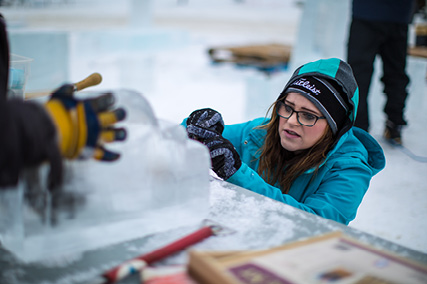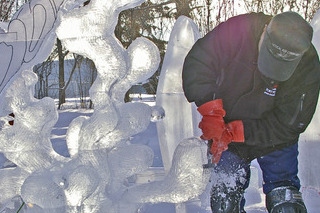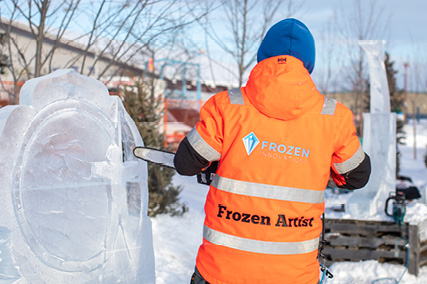Ice Carving
2024 theme: "Artists Choice"
This year our team of professional carvers are creating you a magical land of ice. We heard your feedack from the last event and with the help of the very talented Jesse Forrester and the carving team, we have found unique ways to incorporate new and exciting features that we think you are going to love. Don't worry, even though we have let the carvers bring to life these features in their own way, it will all still be family friendly and a show stopping event. We truly cannot wait to unveil what these talented sculptors are bringing to our community this year.
As you are aware, the weather has not been kind to us so far this year, the unseasonably mild conditions may result in some changes to these ice features, but don't worry it will still be magical.
StoryWalk® in Ice - "Where the Wild Things Are"
 Carver: David Ducharme and Suzanne Ruseler
Carver: David Ducharme and Suzanne Ruseler
Join David and Suzanne as they bring to life a beloved children's book in the heart of Fort St John. Where the Wild Things Are, written and illustrated by Maurice Sendak has been read to children around the world since 1963. We will follow Max as he takes an adventure to an island inhabited by the Wild Things; they will have a wild rumpus, create havoc and dance in the moonlight. This new interactive piece is sure to delight children everywhere, and bring parents back to a place where they may have read this book with their now, grown up children. We have also invited our friends at the Fort St John Literacy Society to host some guided, descriptive reads throughout the High on Ice weekend.
Say Cheese!
Carver: Abram Waterman
 Every year we want to make sure you have an opportunity to celebrate with us - and this year is no different. As you enter the park, Abram (Abe) will have a fun and interactive sculpture for you to get up close and personal with to take some photos with. You'll want to put on your best smile or silly face and say cheese as loud as you can while capturing yourself within the ice sculpture.
Every year we want to make sure you have an opportunity to celebrate with us - and this year is no different. As you enter the park, Abram (Abe) will have a fun and interactive sculpture for you to get up close and personal with to take some photos with. You'll want to put on your best smile or silly face and say cheese as loud as you can while capturing yourself within the ice sculpture.
As everyone is aware, we haven't been graced with the coldest weather so far, so this sculpture may be redesigned for warm weather, it will still allow you an opportunity to get up close, but may be done with safety in mind with our warm weather! Abe is also super talented and will be carving within the Kids Zone and bringing to life the Urban System's Lil' Chippers Wall and fun childrens ice entertainment.
The Fire Tower - IS BACK!! (and better than ever)
Carver: Dmitrii Klimentko
 Dmitrii (Dima) is an extremely gifted sculptor, when we say the fire tower is back it means so much more with Dima on this project. The fire tower this year will include elements that will leave you scratching your head with how in the world he was able to create such an amazing piece of art. You will have to join us again on Sunday during the closing ceremonies when we light this structure on fire and watch as fire and ice combine. This is our feature piece this year, and we couldn't be more excited to have Dima bring a community favorite back to this event.
Dmitrii (Dima) is an extremely gifted sculptor, when we say the fire tower is back it means so much more with Dima on this project. The fire tower this year will include elements that will leave you scratching your head with how in the world he was able to create such an amazing piece of art. You will have to join us again on Sunday during the closing ceremonies when we light this structure on fire and watch as fire and ice combine. This is our feature piece this year, and we couldn't be more excited to have Dima bring a community favorite back to this event.
Single Block Land of Ice
Carver: Kevin Lewis
 We heard from the community that they missed seeing smaller pieces in the park like they had experienced during the drive through events, so we thought - well let's try something new. Join Kevin as he fills a large hex tent with over 20 sculptures that you will be able to tour through and view up close and personal. Will there be wizards, goblins, lions, or creepy crawlies? You will have to explore this new and fun feature for yourself. There will be no touching these pieces, and parents must monitor their children at all times while exploring the land so that it stays in great shape for everyone to enjoy.
We heard from the community that they missed seeing smaller pieces in the park like they had experienced during the drive through events, so we thought - well let's try something new. Join Kevin as he fills a large hex tent with over 20 sculptures that you will be able to tour through and view up close and personal. Will there be wizards, goblins, lions, or creepy crawlies? You will have to explore this new and fun feature for yourself. There will be no touching these pieces, and parents must monitor their children at all times while exploring the land so that it stays in great shape for everyone to enjoy.
Artist Choice with Ryan Cook
Carver: Ryan Cook
 Last year, Ryan delighted us with fun 2 dimensional dinosaurs, and this year we have let him take the reigns. Don't worry, it will still be family friendly, but it's a surprise to see what the final product will be!
Last year, Ryan delighted us with fun 2 dimensional dinosaurs, and this year we have let him take the reigns. Don't worry, it will still be family friendly, but it's a surprise to see what the final product will be!




